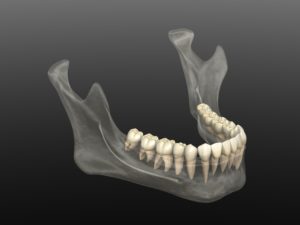 One of the most basic requirements a patient must have in order to get dental implants to replace their missing teeth is a strong and healthy jawbone. However, people who have been missing teeth for a long time often do not have this, as bone degeneration is a common occurrence after tooth loss. Fortunately, techniques known as guided bone regeneration (GBR) and guided tissue regeneration (GTR) can be used to change this, enabling a dentist to help even more people complete their smile.
One of the most basic requirements a patient must have in order to get dental implants to replace their missing teeth is a strong and healthy jawbone. However, people who have been missing teeth for a long time often do not have this, as bone degeneration is a common occurrence after tooth loss. Fortunately, techniques known as guided bone regeneration (GBR) and guided tissue regeneration (GTR) can be used to change this, enabling a dentist to help even more people complete their smile.
What is GBR and GTR?
When a patient has a thin or brittle jawbone that isn’t able to support dental implants, a dentist typically uses something called a bone graft to build it up, which is a procedure in which some of the patient’s own bone or a bone grafting material are applied to the area of the jaw that needs to be strengthened. GBR and GTR are intended to make this procedure more precise so that the growth of the tissue is concentrated exactly on the area where the dental implants are going to be placed.
How Do They Work?
After making a small incision in the gum line to expose the area of the jawbone where the implant post is going to be positioned, a dentist will first apply the bone grafting material to the area. Then, and this is key, they will cover it with something called a barrier membrane. A barrier membrane can be made of either organic or synthetic materials, and its job is to help guide the grafting material as well as stimulate its growth. This approach helps normally slow growing tissues (like bone and gums) grow more rapidly, as well as ensure that the growth is only happening in the areas needed.
After being given a few months to heal, a patient’s jaw should then be thick enough to support a dental implant, which can then be restored to replace their missing teeth.
Do I need GBR/GTR?
If you are interested in getting dental implants, your first step is to visit a local dental implant dentist in your area. They’ll begin the process by performing a thorough exam, and this is when they’ll be able to determine whether or not you need GBR/GTR. Most implant dentists will be able to perform this procedure themselves, though they may need to refer you to a specialist if your situation is more complicated (such as if you have an underlying medical condition).
They typically only take one appointment to complete, and they can make a huge difference in the success of implant surgery. With these procedures, now even more people can benefit from the most state-of-the-art tooth replacement available today.
About the Author
Dr. Charles Parker is a dental implant dentist based in Marshall, TX who serves the entire east Texas area. He has over 30 years of experience placing and restoring dental implants, so if you’re hoping to replace your missing teeth, he’s the man to talk to. To learn more about everything you’ve just read, he can be contacted through his website.
 Request A Free Consultation
Request A Free Consultation
